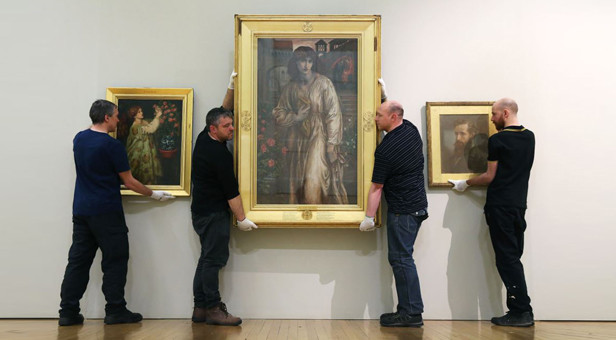
Rossetti’s masterpieces: Three major works by Rossetti identified by Duke’s go on show in an exhibition at The Walker Art Gallery in Liverpool

Monna Rosa by Rossetti: it shows Mrs Leyland arranging flowers in a vase that is still owned by the family
Two Pre-Raphaelite masterpieces by the artist Dante Gabriel Rossetti are to go on display after being hidden from public view for more than a century.
They were spotted hanging in a private house by Guy Schwinge from Duke’s auction house in Dorchester.
A third painting by the master, of his patron Frederick Leyland, was also uncovered and all go on show at The Walker Art Gallery in Liverpool in an exhibition between February 12 and June 5.
After spotting the paintings in the home of direct descendants of Leyland, Mr Schwinge said: “To find a single Rossetti in a house is quite exceptional.
“To find two major works by the artist and a portrait of his greatest patron is almost unbelievable.”
Quality works by Rossetti sell for millions and the Pre-Raphaelite brotherhood to which he belonged was founded in 1848 and had a major influence on the art world.
After discovering the paintings, Mr Schwinge contacted Christopher Hewall, one of the world’s leading Pre-Raphaelite experts, and the exhibition: ‘Pre-Raphaelites: Beauty and Rebellion’ began to take shape with The National Museums of Liverpool.
The paintings loaned by Leyland’s descendants to the exhibition, and which were spotted by Mr Schwinge, include ‘The Salutation of Beatrice’, which is regarded as one of Rossetti’s last masterpieces.
The painting represents a familiar theme to the artist and depicts his muse, Jane Morris, cast as Beatrice Portinari, the subject of medieval poet Dante’s ‘Unrequited Love’.
The figure of Beatrice dominates the foreground with her beguiling expression and the trademark of Pre-Raphaelite beauty, an abundance of tumbling auburn locks.
The painting illustrates lines from the second sonnet in Dante’s ‘Vita Nuova’ (New Life) and a quotation from the pairing can be found on the original frame.
Frederick Leyland originally owned two versions of the same painting – the other is in the collection of the Toledo Museum of Art, Ohio, USA, but the whereabouts of this second work has remained a mystery – until now.
The other work is a stunning portrait of Leyland’s auburn haired wife entitled ‘The Monna Rosa’.
The striking portrait, painted in 1867, shows Leyland’s wife arranging flowers in a Chinese blue and white vase. The vase remains in the collection of the family.
Frederick Leyland was arguably Rossetti’s most significant patron.
He was a Liverpool-born ship owner and art collector and his wealth enabled him to patronise the revolutionary painters of the Pre-Raphaelite brotherhood, which changed the face of British art in the 19th century.
A spokesman for the Walker Art Gallery said: “We are grateful to Guy Schwinge of Duke’s for helping secure these paintings for the exhibition.”
Mr Schwinge added: “I know that the experts at the Walker Art Gallery are extremely grateful to the owners for allowing these exceptional works to go on show to the general public for the first time in over a century.”
Ann Bukantas, Head of Fine Art at The National Museums, Liverpool, said: “The Salutation is a significant addition to the exhibition.
“For an art movement as enduringly popular as the Pre-Raphaelites, it is rare to uncover paintings such as this which are not well documented or exhibited.
“In subject matter and style it is typical of Rossetti and we know our visitors will relish the chance to get a close look at this late painting of the artist – one of his final major works – for the first time.
“We are thrilled to be showing these three works together for the first time. As arguably Rossetti’s most significant patron, this focus on work Leyland commissioned and bought helps us understand the dynamics of their relationship.”
The Pre-Raphaelite brotherhood intended to reform art by rejecting what it considered the mechanistic approach first adopted by Mannerist artists who succeeded Raphael.
Its members believed the classical poses and elegant compositions of Raphael in particular had been a corrupting influence on the academic teaching of art, hence the name ‘Pre-Raphaelite’. Rossetti died in 1882.
Guy Schwinge of Duke’s, who was instrumental in securing the paintings for exhibition, has a reputation for discovering lost masterpieces.
Last year, he spotted another Rossetti on the back stairs of a country house, which was later sold at auction.
Previously, he identified a pair of small paintings on panel behind the bedroom door of a house in Oxford, which turned out to be lost works by the Renaissance Master Fra Angelico.
These were subsequently sold at auction by Duke’s for almost £2 million.






